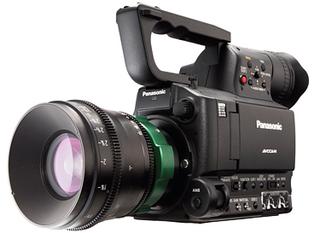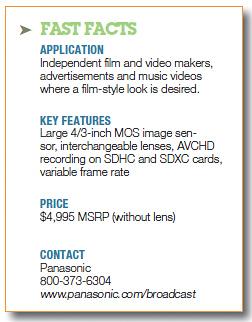Panasonic AG-AF100 HD Camcorder
The Panasonic AG-AF100 is the industry's first attempt to provide an answer to the DSLR revolution started by Canon's popular large-sensor still cameras with HD video capability. The problem has been that DSLR cameras were not designed for motion picture use, and hence lack the ergonomics and features of a professional video camera. The AF100 combines a large image sensor and interchangeable lenses with a standard professional video camera design.
FEATURES

Panasonic’s AG-AF100 Large Sensor HD Camcorder The key feature that sets this camera apart from the others is the 4/3-inch sensor size, which is four times larger than the typical 2/3-inch sensor found in higher end professional camcorders, and almost the size of the 35mm film image. This translates into a shallower depth of field, and an image quality approaching 35mm motion pictures.
Interchangeable lenses are a key element in image control, and they have traditionally been unavailable on video cameras in this price range. The AF100 has an interchangeable micro 4/3-inch lens mount that can also take adapters for standard 35mm and other lenses.
Behind the lens is a fully professional video camera with features that surpass the DSLR design. As the AF100 is engineered solely for motion picture, it can employ technology such as an optical low-pass filter to eliminate aliasing and minimize skew.
The AF100 records in 1080 (60i, 50i, 30p, 25p and 24p native) and 720 (60p, 50p, 30p, 25p and 24p native) standards. It also can shoot a variable frame rate for in-camera slow of fast motion.
The AF100 records onto inexpensive SDHC or SDXC memory cards using AVCHD compression at 24 Mbps. The new SDXC cards support capacities up to 64 GB and a faster data rate. The two relay recording slots allow for up to 12 hours of recording time in the highest quality mode. However, you are not limited to the AVCHD compression codec, as the camera has an HD-SDI out that can be connected to an alternative recording device. It also has an HDMI output for easy monitor connection.
The audio capability is optimized with uncompressed 16-bit LPCM two-channel digital audio. And the two on-board XLR inputs with 48 Volt DC phantom power allow users to connect the professional microphones that the DSLR systems lack.
The camera controls layout is similar to that on Panasonic's HVX200 and HPX170. The essential controls—gain, iris, audio level, shutter speed, frame rate, and white balance—are found on the camera as dials and switches, providing fast access. The AF100 is equipped with a high-definition color LCD screen that flips out and rotates into any position, as well as a color eyepiece viewfinder, which is useful in bright sunlight.
The AF100 has most of the features found on Panasonic's P2 cameras, including a waveform monitor, vectorscope, user settings, and six scene files to create film-like looks and customized image profiles.
Of course, the main attraction of this camera is the image sensor and image processing. The 4/3-inch sensor is a MOS type, which Panasonic claims to be superior to the CMOS sensor because it has a larger light receiving area. They added 18-bit DSP and advanced noise reduction to create a clean image.
IN USE
The question everyone is asking is if this camera delivers the image quality of DSLRs.
I tested the AF100 using a Panasonic Lumix 14-140mm zoom lens. To achieve a more film-like look, I shot footage in the 1080/24p mode and chose Scene File 5, which creates a film-like color profile. I then proceeded to shoot indoor and outdoor footage to evaluate the camera's low light and high contrast handling capabilities.
In the past, I have had some qualms about the AVCHD codec, due to its high compression. When testing the Panasonic HMC-150 previously, I found the highlights were discolored and blew out easily. Happily, this was not the case with the AF100. Highlights and overexposed areas in a sunlit landscape were handled well. It appears that the AF100 is engineered to overcome problems in handling high contrast and low light, and these limitations do not reside in the AVCHD codec.
In low light situations, the camera also performed quite well. In film mode, it registers gain as ISO, and you can go as high as 3200. I found that even at this high sensitivity level, image noise was low; much lower than the equivalent ISO on a DSLR. Overall, the AF100 creates a very clean image with a noise level far below that of DSLRs.
The AF100 is also very effective in minimizing aliasing and skew. Diagonal lines are clean and show no signs of "stair stepping."
I ran the camera through the full range of slow and fast motion and found this feature to be excellent—and it works in 1080/24p. In the past, most cameras have enabled variable frame rate in 720p only.
Memory card efficiency is outstanding with the AF100. The SDHC cards are very robust, and I was unable to create errors. I even turned the camera off while recording a shot and the scene was still preserved on the memory card.
The AVCHD codec delivers a surprisingly good image, but many people have complained about the difficult file structure that makes it hard to manage clips and complicates importing into NLE systems. Currently there are some issues concerning the ease of importing and managing AVCHD files, but Panasonic is in the process of addressing this. They will be releasing a free AVCCAM Importer download later this year, and that's expected to address these issues.
A real plus, for those averse to the AVCHD codec, is the HD SDI output which allows recording to an external device, such as the Convergent Design nanoFlash recorder, using far less compression. (The AF100 would reach its greatest potential with high-end 35mm lenses recording through HD SDI.)
In general, the image compares favorably with footage shot on the Canon 7D. There are footage comparisons all over the Internet, but most of them are not fair. To really see what the AF100 can do, you need to use comparable lenses, shoot identical shots and apply equivalent color correction. Out of the box, the colors on the AF100 may seem paler depending on the scene file used, but people shouldn't judge the camera by that. In fact, it's an advantage. The color space is there and it is usually better to achieve color enhancement in post than to be limited by in-camera processing.
SUMMARY
The great leap forward with the AF100 is a true video camera design with the potential to shoot DSLR quality images. There is no denying that as nice as the DSLR images are, the lack of XLR inputs and a still camera design are significant impediments to mobile shooting. The AF100 has all of the features videographers need, while offering a low depth of field and a wide choice of lenses.
The camera is not yet the "Holy Grail," however. The size is still a bit awkward, as it's too small to use as a shoulder-mounted camera. However, this is a great first step towards making the kind of video camera that is most sought after by independent filmmakers and videographers. In terms of lens choice, the AF100 could use more. What I would like to see is a standard lens mount designed to accommodate the most common 35mm lenses. I also find the AVCHD codec file structure cumbersome and would like to see more codec options, and possibly a P2 version to handle higher data rate. And finally, a larger, shoulder-mount form factor would offer more versatility in the field.
Panasonic should be applauded once again for leading the way in camera development by listening to what motion picture makers want. The AF100 signals a new direction that will lead to more models with further refinements and options; however, that doesn't mean you shouldn't buy one now. The AF100 offers the classiest image of any video camera in its price range, and is superior to its small sensor predecessors. Panasonic has opened the door to a new era, where larger sensors and greater lens choices provide romantic photographic images previously unattainable in a low-cost video camera.
Geoff Poister, Ph.D., is a member of the Film and Television faculty at Boston University and a regular contributor to TV Technology.

Get the TV Tech Newsletter
The professional video industry's #1 source for news, trends and product and tech information. Sign up below.
